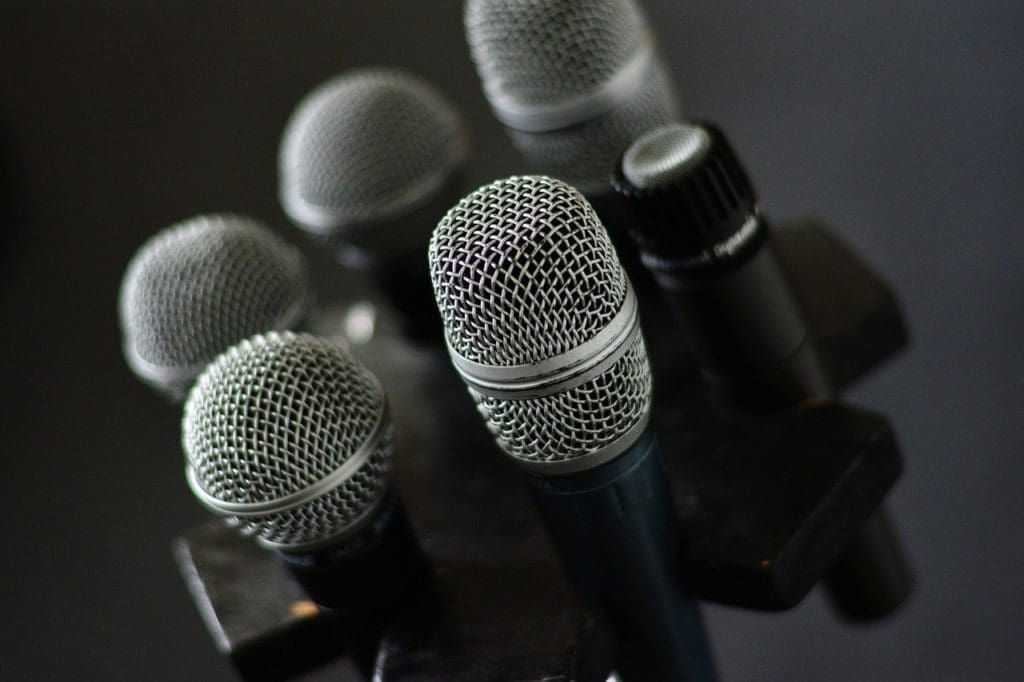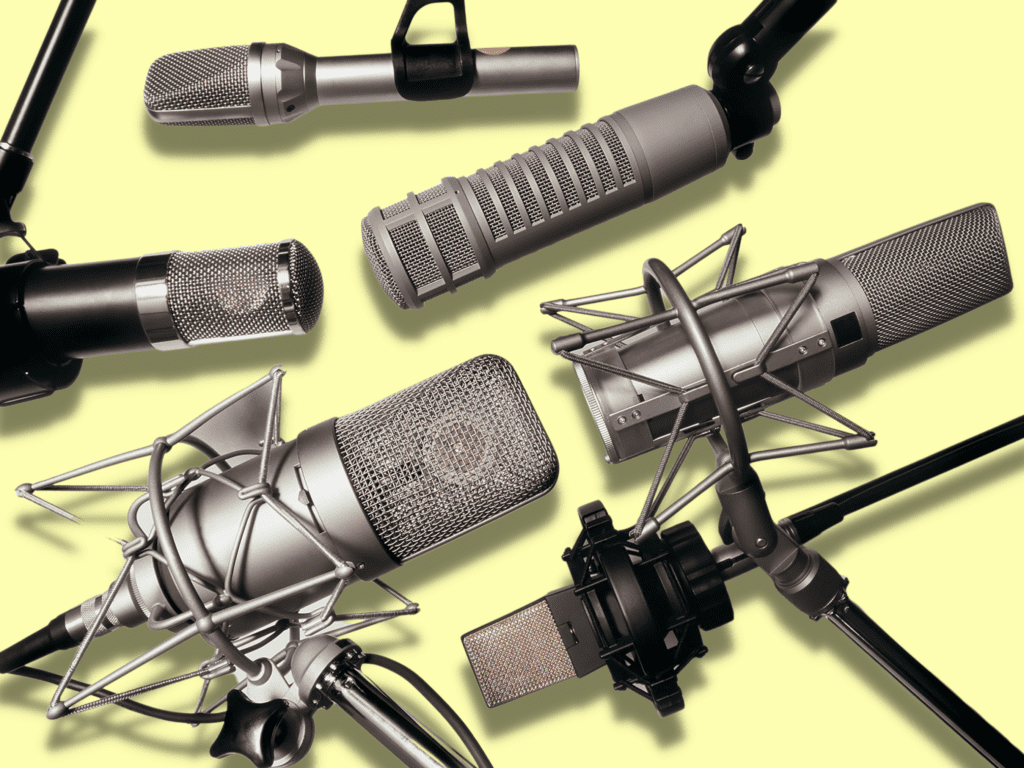
Choosing the Best Podcast Microphone
Testing 1, 2, 3. Is this thing on? Welcome to the start of podcast production. Today, we’re discussing podcast microphone attributes. I’ll be your host for the second pillar of our podcasting journey. Can everyone hear me? For the next several weeks we will be talking about production and the equipment, software, and the how-to’s of making your podcast a quality production.
As a podcaster, you have an advantage over the production of other social formats, such as video for example. You do not need to worry if you’re getting the shot, or even deciding on establishing the shot. You do not have to fret about lighting, or framing a scene. Your concern is with sound, and how your voice and those you interview will sound. This concern can be your friend, or your nemesis.
In today’s technology market there is no excuse for poor quality when it comes to recording. With a plethora of gear and applications, I can imagine your head may be spinning right about now. It can all add up in the good ol’ wallet department too, but don’t stress, there are a variety of microphone options to serve your needs. We’ll go over a few and hopefully by the end of this production section, you will have a better understanding of what you have, what you need, and what you can afford.
The Best Podcast Microphone Types
Selecting a microphone can seem overwhelming. When someone says microphone, I can guess the usual image that pops into a person’s head is another person holding an item that looks like a metal corded ice cream cone. It’s kind of universal. There’s also the image of a mini microphone that clips to an article of clothing used in TV and Film, known as “lavalier” or “lapel” microphones. Even your cellphone is a common visual of a microphone. However, none of these are what we will be discussing here today. Yes, you can use these microphones for podcasting, but they’re not ideal for recording. The three basic types include:
- Dynamic microphones
- Ribbon microphones
- Condenser microphones
If you delve in deeper there are components to these mics such as; type of diaphragm, the pattern at which the sound is collected, size and cost. For our podcast purposes, we will be discussing dynamic and condenser microphones.

Dynamic vs. Condenser Mics
Condenser Microphones
Let’s stop for a moment and imagine a plate filled with a Thanksgiving meal. Stay with me here. You’ve got your mashed potatoes, you’ve got your turkey, cranberry, squash, and a nice fresh roll with butter, all separated neatly on your plate. Then grandma hands you the gravy. What happens? Things begin to seep into one another, right? Although still good, your plate may appear a bit more unattractive. This is what a condenser microphone does to podcast audio.
Condenser microphones are much more sensitive to sound and will easily pick up room tone and outside noise. If you’re recording in an acoustically treated place, you may be able to get away with using a condenser microphone, but for the average podcaster, you’re likely going to be picking up unwanted noise and even microphone bleed from co-hosts and guests. Although wonderful for music, because when making an album room tone can provide great color to your sound, condenser microphones are not as preferred for podcast microphones.
If you think of your separate pieces of your plate as people or objects in a room, ready to participate in your podcast, and the gravy as the microphone that will capture your sound, you get the gist of how a condenser mic works. The microphone absorbs all the sounds of the room and people, creating a big hodge-podge of noise, which isn’t conducive to a podcast. Again, great for recording music, giving it a bigger fuller sound, but let’s face it here, we aren’t laying down tracks for the next Grammy winner. Or are you?
If so you can stop reading now, as you likely know more than me about which microphones to use in different situations. This reason alone would be enough for you not to use this style of microphone for podcasting. Condensers also cost the bank. You can spend thousands of dollars on a condenser mic, and you kind of have to because the cheap ones sound like crap! Either way, stay away from condenser microphones for podcasting, unless you’re laying down tracks for the next Grammy winner, then, by all means.
Dynamic Microphones
Sticking with the lovely meal we imagined, let’s move onto dessert. Along with her amazing gravy, grandma has also made a pie, it’s rich and delicious. Normally she’d cut and serve it with a pie spatula, but last year Uncle Albert bought her a lovely pie and cake cutter that divides the dessert into equally cut pieces that stay separated by the utensil. This is our dynamic microphone. A dynamic mic stops the majority of surrounding room noise by mostly isolating the voice that is speaking into it. Dynamic microphones typically pick up sound in a cardioid pattern (condensers can be cardioid too).
When a mic picks up sound via a cardioid, it does a GREAT job of picking up the sound that’s coming directly into the center of it with a little on each side. This cardioid pattern of taking in incoming sound is shaped like a heart. They’re also tough and can withstand rough use. These types of microphones still give a rich sound without being diluted by other noises, or people talking in the room. Dynamic microphones are great for podcasting, and most radio stations and broadcasting studios use them. They are the type of microphone we, as podcasters, want in our kit.
** We review products independently, but may receive a commission if you purchase any of the below products through our links. **
Top 4 Podcast Microphones
1. Audio-Technica ATR2100x-USB Cardioid Dynamic Microphone – $79
The ATR 2100x is both an XLR and USB dynamic microphone that packs a big punch. Don’t be fooled by its price. A perfect mic for podcasters, the ATR2100x-USB captures high-quality sound with its 192kHz sampling rate and low self noise. There’s a headphone jack on the mic, so you can directly monitor incoming and outgoing sound.
FEATURES:
- Connection via XLR or USB.
- High-quality A/D conversion up to 192kHz sampling rate.
- Cardioid polar pattern rejects unwanted noise from the back and sides.
- Built-in headphone jack.
- Desktop stand included.
- Ships with a USB-C to USB-C cable and a USB-C to USB-A cable.
2. Shure SM58 – Cardioid Dynamic Microphone – $109
The Shure SM58, the quintessential vocal microphone that can be seen on stages and in recording studios across the world. This microphone does a great job at rejecting background noise and has a frequency response that emphasizes the human voice. It’s also really rugged. It can be dropped and banged around and will still work flawlessly.
FEATURES:
- Bright midrange that’s tailored to boost the human voice.
- Cardioid polar pattern.
- Low handling noise.
- Rugged.
3. Rode PodMic – Cardioid Dynamic Podcast Microphone – $99
The Rode PodMic is a broadcast quality microphone that was literally built by Rode for podcasters. One really cool feature is that it has an anti-plosive build, so you don’t have to worry about getting a pop blocker or popping your p’s. The PodMic is designed to enhance your voice and deliver that up close, rich, broadcast tone.
FEATURES:
- Handles loud and quiet sounds.
- All metal construction.
- Internal shock mounting .
- Lightweight.
4. Shure SM7B – Cardioid Dynamic Microphone – $399
First and foremost, the Shure SM7Blooks badass. You’ve probably seen your favorite podcaster or YouTube personality using this mic. It looks great on camera. With this baby you can capture crisp, upfront vocals that will shine in your mix. Like the Rode PodMic, the SM7B also has a built-in pop filter so you don’t have to worry about buying a pop blocker. This microphone does an excellent job of rejecting outside noise, so you don’t have to worry about that fan of yours or the hum of your air conditioning ruining a good podcast.
FEATURES:
- Shielding against broadband interference.
- Flat frequency response.
- Internal shock mount.
- Built-in pop blocker.
All four of these are great podcast microphones. Anyone worth their salt in podcasting will know of these microphones and has probably used one of them. These are extremely popular podcasting microphones. Just a side note: the Shure SM58 is maybe the most popular dynamic microphone in the world and can be seen on stages and in theatres across the world – I digress. With this range of costs, there is sure to be one that can fit into your budget. If all else fails, grandma may need Christmas gift ideas.
Another consideration when purchasing your podcast microphone will be how it connects to the device you are capturing audio in. These types of microphones commonly use XLR connectors. The XLR Cable is the 3-pin cable that connects to recorders and audio interfaces. Some dynamic mics can also connect via USB and plug directly into your computer. I’m not in love with USB microphones for podcasting, but if you want simplicity, the Rode NT-USB Mini is a rad dynamic mic that will sound solid for recording podcasts.
Let’s Recap
There are a lot of microphones out there. With this information in mind, take the time to look through the various brands/reviews, how much they cost vs. what you can afford, and how they connect. You are starting out, so don’t be afraid to try something with a lower cost, and then buy something better down the line if you feel you need to. If your wallet says you can afford it, then buy the best one for your needs, and check that worry off your to-do list right away.
Either way, grandma is still going to make you gravy and pie. Look at that, we’ve set the foundation for our second pillar. You can find out what other microphones we stand by in our guide The Four Pillars of Podcasting. Once you have a good microphone, you can move onto setting up your space, picking the DAW or recorder that works best for you, and actually record your show. You’re on your way to getting your words, your message, and your podcast out there to the masses. Now, please pass the drumsticks.




